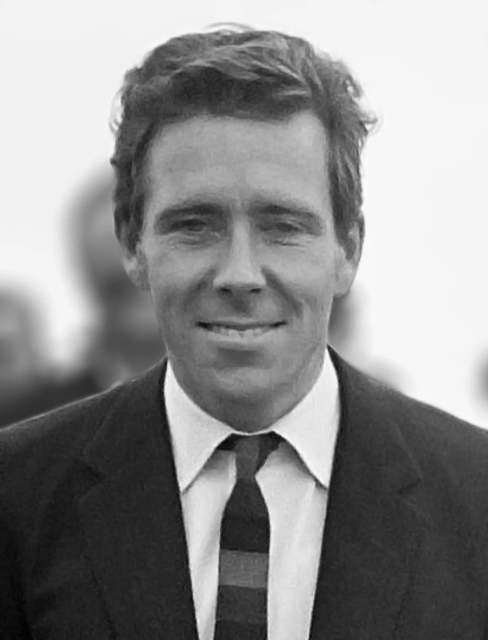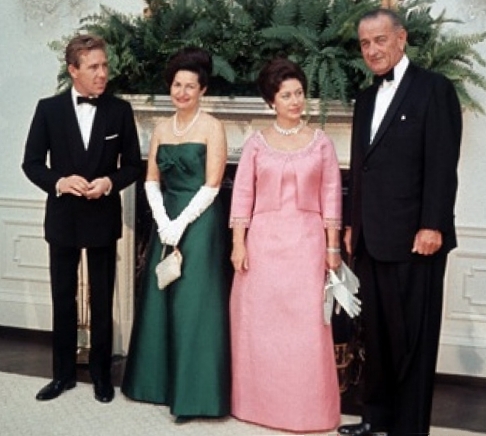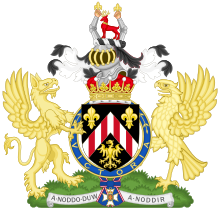Antony Armstrong-Jones, 1st Earl of Snowdon

Antony Armstrong-Jones, 1st Earl of Snowdon

The Right Honourable The Earl of Snowdon GCVO FRSA RDI | |
|---|---|
| Member of the House of Lords Lord Temporal | |
| In office 16 November 1999 – 31 March 2016 Life peerage | |
| In office 6 October 1961 – 11 November 1999 Hereditary peerage | |
| Personal details | |
| Born | Antony Charles Robert Armstrong-Jones (1930-03-07)7 March 1930 Belgravia, London, England |
| Died | 13 January 2017(2017-01-13)(aged 86) Kensington, London, England |
| Resting place | St Baglan's Church, Llanfaglan, Wales |
| Nationality | British |
| Spouse(s) |
|
| Children |
|
| Parents |
|
| Alma mater | Jesus College, Cambridge |
| Occupation | Photographer |
Antony Charles Robert Armstrong-Jones, 1st Earl of Snowdon, GCVO, FRSA, RDI (7 March 1930 – 13 January 2017), commonly known as Lord Snowdon, was a British photographer and filmmaker. He was the husband of Princess Margaret and brother-in-law of Queen Elizabeth II.
The Right Honourable The Earl of Snowdon GCVO FRSA RDI | |
|---|---|
| Member of the House of Lords Lord Temporal | |
| In office 16 November 1999 – 31 March 2016 Life peerage | |
| In office 6 October 1961 – 11 November 1999 Hereditary peerage | |
| Personal details | |
| Born | Antony Charles Robert Armstrong-Jones (1930-03-07)7 March 1930 Belgravia, London, England |
| Died | 13 January 2017(2017-01-13)(aged 86) Kensington, London, England |
| Resting place | St Baglan's Church, Llanfaglan, Wales |
| Nationality | British |
| Spouse(s) |
|
| Children |
|
| Parents |
|
| Alma mater | Jesus College, Cambridge |
| Occupation | Photographer |
Early life
Armstrong-Jones's paternal grandfather was Sir Robert Armstrong-Jones, the British psychiatrist and physician.[5] His paternal grandmother, Margaret Armstrong-Jones (née Roberts), was the daughter of Sir Owen Roberts, the Welsh educationalist.[6] A maternal uncle was Oliver Messel (1904–1978); a maternal great-grandfather was the Punch cartoonist Linley Sambourne (1844–1910); and his great-great-uncle Alfred Messel was a well-known Berlin architect.[7] Additionally, his great-great-grandmother, Frances Linley, was a first cousin of Elizabeth Linley, wife of Richard Brinsley Sheridan.[8]
Education
Armstrong-Jones was educated at two independent boarding schools: first at Sandroyd School[12] in Wiltshire from the autumn term of 1938 to 1943.
Armstrong-Jones then attended Eton College, beginning in the autumn term ("Michaelmas half") of 1943.[13] In March 1945, he qualified in the "extra special weight" class of the School Boxing Finals.[14] He continued to box in 1946, gaining at least two flattering mentions in the Eton College Chronicle.[15] While on holiday at his father's family estate in North Wales (Plas Dinas), he was stricken with poliomyelitis.[16] In 1947, he was a coxswain in Eton's traditional "Fourth of June" Daylight Procession of Boats.[14]
He then matriculated at the University of Cambridge, where he studied architecture at Jesus College but failed his second-year exams.[17] He coxed the winning Cambridge boat in the 1950 Boat Race.[18]
Life and career

Armstrong-Jones in 1958, photographed by Carl Van Vechten
After university, Armstrong-Jones began a career as a photographer in fashion, design and theatre. His stepmother had a friend who knew Baron the photographer; Baron visited Armstrong-Jones in his London flat, which doubled as his work studio.[19] Baron, impressed, agreed to bring on Armstrong-Jones as an apprentice, first on a fee-paying basis[19] but eventually, as his talent and skills became apparent to Baron, as a salaried associate.[20]
Much of his early commissions were theatrical portraits, often with recommendations from his uncle Oliver Messel, and "society" portraits highly favoured in Tatler, which, in addition to buying a lot of his photographs, gave him byline credit for the captions.[21] He later became known for his royal studies, among which were the official portraits of Queen Elizabeth II and the Duke of Edinburgh for their 1957 tour of Canada.[22] He was also an early contributor to Queen magazine, the magazine founded by his friend Jocelyn Stevens.[23][24]
In the early 1960s, Armstrong-Jones became the artistic adviser of The Sunday Times Magazine, and by the 1970s had established himself as one of Britain's most respected photographers. Though his work included everything from fashion photography to documentary images of inner city life and the mentally ill, he is best known for his portraits of world notables, many of them published in Vogue, Vanity Fair, and The Daily Telegraph magazine. His subjects include Marlene Dietrich; Laurence Olivier; Maggie Smith; Leslie Caron; [21] Lynn Fontanne; [21] David Bowie; Elizabeth Taylor; Rupert Everett; Anthony Blunt;[25] David Hockney;[26] Princess Grace of Monaco; Diana, Princess of Wales; Barbara Cartland; Raine Spencer (when she was Lady Lewisham); Desmond Guinness;[26] British prime minister Harold Macmillan;[26] Iris Murdoch;[26] Tom Stoppard;[26] Vladimir Nabokov[26] and J. R. R. Tolkien.[27] Over 100 of his photographs are in the permanent collections of the National Portrait Gallery in London.[28]
In 1968 he made his first documentary film, Don't Count the Candles,[29] for the US television network CBS, on the subject of ageing. It won seven awards[30] including two Emmys.[31][32] This was followed by Love of a kind (1969), about the British and animals,[33] Born to be small (1971) about people of restricted growth[34] and Happy being happy (1973).[35]
In October 1981 a group portrait by Snowdon of the British rock band Queen was used on the cover of their Greatest Hits album. In 2000 A Snowdon portrait of Freddie Mercury was used on the cover of his The Solo Collection box set.
In 2000, Armstrong-Jones was given a retrospective exhibition at the National Portrait Gallery, Photographs by Snowdon: A Retrospective,[36] which travelled to the Yale Center for British Art the following year.[37] More than 180 of his photographs were displayed in an exhibition that honoured what the museums called "a rounded career with sharp edges".[37]
In 2006, Tomas Maier, creative director of the Italian fashion brand Bottega Veneta, sought Snowdon to photograph his Fall/Winter 2006 campaign.[40]
Designs and inventions
Armstrong-Jones co-designed (in 1963, with Frank Newby and Cedric Price) the "Snowdon Aviary" of the London Zoo (which opened in 1964); he later said it was one of his proudest creations, affectionately calling it the "birdcage".[11] He also had a major role in designing the physical arrangements for the 1969 investiture of his nephew Prince Charles as Prince of Wales.[41]
He was granted a patent for a type of electric wheelchair in 1971.[42]
Philanthropy and charity
In the 1960s, he served in the capacity of a council member of the Polio Research Fund,[45] as it was known before it was renamed the National Fund for Research into Crippling Diseases. He served as a trustee of the National Fund for Research into Crippling Diseases (since renamed Action Medical Research).[21] He was president for England of the International Year of Disabled Persons in 1981.[43] He was provost of the Royal College of Art from 1995 to 2003.[46]
Personal life
Snowdon was married twice. He was married first to Princess Margaret (1960 to 1978), and second to Lucy Mary Lindsay-Hogg (1978 to 2000).[47]
First marriage

Princess Margaret and the Earl of Snowdon with the United States president Lyndon B. Johnson and his wife Lady Bird at the White House on 17 November 1965
In February 1960, Snowdon, then known as Antony Armstrong-Jones, became engaged to the Queen's sister, Princess Margaret, and they married on 6 May 1960 at Westminster Abbey. The ceremony was the first royal wedding to be broadcast on television.[48] Despite the public enthusiasm, "some critics disapproved of a commoner marrying into the royal family".[49] The couple made their home in apartments at Kensington Palace. He was created Earl of Snowdon and Viscount Linley, of Nymans in the County of Sussex, on 6 October 1961.[50] The couple had two children: David, 2nd Earl of Snowdon, born 3 November 1961, and Lady Sarah, born 1 May 1964.[51]
The marriage began to collapse early and publicly; various causes may have been behind the failure. On her side there was a penchant for late-night partying, while on Snowdon's part there was an undisguised sexual profligacy. ("'If it moves, he'll have it', was the summing-up of one close friend.")[52] "'[T]o most of the girls who worked in the Pimlico Road studio, there seemed little doubt that Tony was gay'. To which Tony responds: 'I didn't fall in love with boys - but a few men have been in love with me.'"[52] The authorised biography by Anne de Courcy (2008) reveals a series of affairs with women, including a 20-year relationship with his mistress Ann Hills,[53] and that Armstrong-Jones did not deny that he was bisexual.[47]
In his 2009 memoir, Redeeming Features, British interior designer Nicholas Haslam claimed that he had an affair with Snowdon before the latter's marriage to Princess Margaret and that Snowdon had also been the lover of Tom Parr, another leading interior designer.[54]
The couple remained married sixteen years. "They were both pretty strong-willed and accustomed to having their own way, so there were bound to be collisions," according to de Courcy. His work also consumed a great deal of time. "She expected her husband to be with her more, but one of Tony's strongest motivations was work."[55] The marriage was accompanied by drugs, alcohol and bizarre behaviour by both parties, such as his leaving lists of "things I hate about you" for the princess to find between the pages of books she read. According to biographer Sarah Bradford, one note read: "You look like a Jewish manicurist and I hate you".[56] When high society palled upon Snowdon, he would escape to a hideaway cottage with his lovers or on overseas photographic assignments; "[m]ost people, including the Royal Family, took his side."[52] Among Snowdon's lovers in the late 1960s was Lady Jacqueline Rufus-Isaacs, daughter of the 3rd Marquess of Reading.[47] In spite of her own affairs, Margaret was said to be particularly upset when hearing about this woman.[55] They separated in 1976, and the marriage ended in divorce in 1978.[51]
In 2004, The Sunday Telegraph reported that Snowdon had fathered an illegitimate daughter shortly before marrying Princess Margaret.[57] Anne de Courcy reports the claim by Polly Fry, born on 28 May 1960, in the third week of Lord Snowdon's marriage to Princess Margaret, and brought up as a daughter of Jeremy Fry, inventor and member of the Fry's chocolate family, and his first wife, Camilla, that she was in fact Snowdon's daughter.[58] Polly Fry asserted that a DNA test in 2004 proved Snowdon's paternity. Jeremy Fry rejected her claim, and Snowdon denied having taken a DNA test. However, four years later, he admitted that this account was true.[47][57]
Second marriage
After his divorce from Princess Margaret, Lord Snowdon married Lucy Mary Lindsay-Hogg (née Davies) on 15 December 1978. Armstrong-Jones's youngest daughter with Lucy Mary is Lady Frances Armstrong-Jones, a designer and board member of the Snowdon Trust.[59] She was born on 17 July 1979 and married Rodolphe von Hofmannsthal in 2006.[60] From 1976 until 1996, Snowdon also had a mistress, journalist Ann Hills. She died by suicide on 31 December 1996.[47]
Death
Lord Snowdon died peacefully at his home in Kensington on 13 January 2017, aged 86.[63]
His funeral took place on 20 January at St Baglan's Church in the remote village of Llanfaglan near Caernarfon. He was buried in the family plot in the churchyard.[64]
Titles, styles, honours and arms
Titles
7 March 1930 – 6 October 1961: Mr Antony Armstrong-Jones
6 October 1961 – 13 January 2017: The Right Honourable The Earl of Snowdon 16 November 1999 – 13 January 2017: The Right Honourable The Lord Armstrong-Jones
Peerage
Following his wedding, Armstrong-Jones was granted an earldom[65] and introduced to the House of Lords as the Earl of Snowdon on 28 February 1962.[66] The awarding of the earldom was in line with the practice of granting titles upon marriage into the Royal Family.[67] Snowdon was appointed Constable of Caernarfon Castle in 1963; as part of this role, he assisted in organising the Investiture of the Prince of Wales in 1969.[22][68]
On 16 November 1999 Lord Snowdon was created Baron Armstrong-Jones, of Nymans in the County of West Sussex.[71] This was a life peerage given to him so that he could keep his seat in the House of Lords after the hereditary peers had been excluded. An offer of a life peerage was made to all hereditary peers of the first creation (those for whom a peerage was originally created, as opposed to those who inherited a peerage from an ancestor) at that time.[72] The government of the day had expected Lord Snowdon to follow the example of members of the royal family and turn down his right to a life peerage. At the time, Labour MP Fraser Kemp said he was "shocked and surprised that someone who achieved their position in the House of Lords by virtue of marriage should accept a seat in the reformed Lords".[72]
Awards and honours
Arms
 |
|
Issue
| Name | Birth | Marriage | Issue | |
|---|---|---|---|---|
| Polly Fry | 28 May 1960 | Barnaby Higson[57] | 5 children[57] | |
| David Armstrong-Jones, 2nd Earl of Snowdon | 3 November 1961 | 8 October 1993 | Serena Stanhope | Charles Armstrong-Jones, Viscount Linley Lady Margarita Armstrong-Jones |
| Lady Sarah Armstrong-Jones | 1 May 1964 | 14 July 1994[82] | Daniel Chatto | Samuel Chatto[83] Arthur Chatto[83] |
| Lady Frances Armstrong-Jones | 17 July 1979 | 2 December 2006[60] | Rodolphe von Hofmannsthal[60] | Rex von Hofmannsthal[84] Maud von Hofmannsthal[85] Sybil von Hofmannsthal |
| Jasper Cable-Alexander | 30 April 1998 | |||
Ancestry
See also
List of Cambridge University Boat Race crews
List of Old Etonians born in the 20th century
List of photographers
List of University of Cambridge members